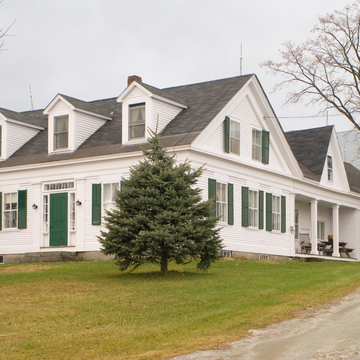Ashbel Martin, a grandson of early Peacham settler Asahel Martin, established this farm about the time he married Hannah Wesson in 1857, when he was twenty-seven. He built a Greek Revival one-and-a-half-story house detailed in typical upper Connecticut River Valley style, with a rear ell and attached horse barn, all with corner pilasters and heavy entablatures running at the eaves. Together with his sons Moses and Edwin, Ashbel managed a large farm of three hundred and fifty acres, plus one hundred and fifty acres of additional pasture and woodland with more than one thousand sugar trees. He also bred and dealt in Hereford cattle. In c. 1885 he built a barn to house his Devon cows and other head of stock. This landmark barn of post-and-beam construction is two hundred feet long with two hipped and flared cupolas. It is a bank barn with a gabled haymow entrance and stables, which are over a manure basement. The cupolas ventilate both levels of the barn by means of internal wooden ducts. The farm has remained in the family and is kept in agricultural production. Today, the barn basement is converted to free-stall use.
You are here
Ashbel Martin Farm
If SAH Archipedia has been useful to you, please consider supporting it.
SAH Archipedia tells the story of the United States through its buildings, landscapes, and cities. This freely available resource empowers the public with authoritative knowledge that deepens their understanding and appreciation of the built environment. But the Society of Architectural Historians, which created SAH Archipedia with University of Virginia Press, needs your support to maintain the high-caliber research, writing, photography, cartography, editing, design, and programming that make SAH Archipedia a trusted online resource available to all who value the history of place, heritage tourism, and learning.









